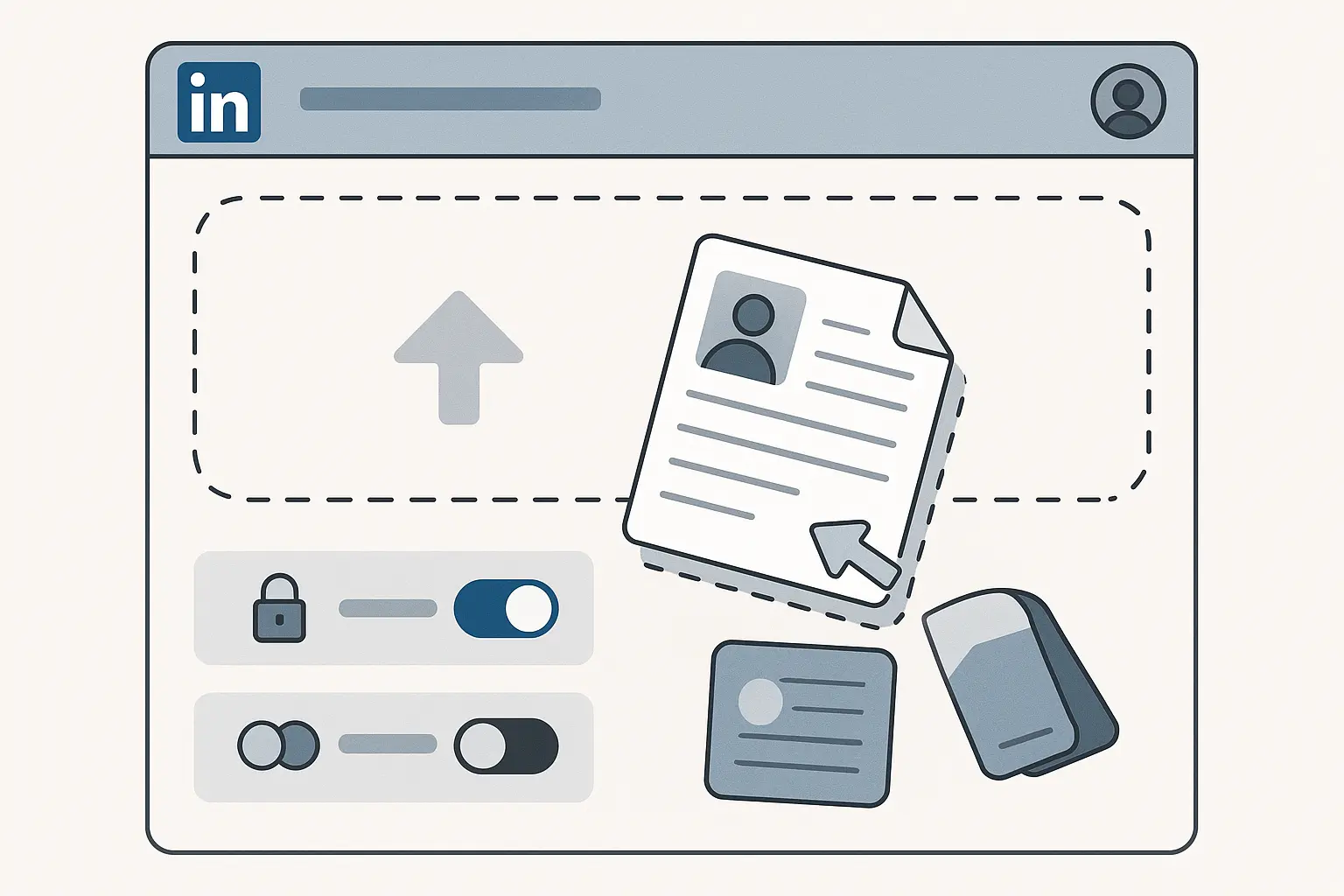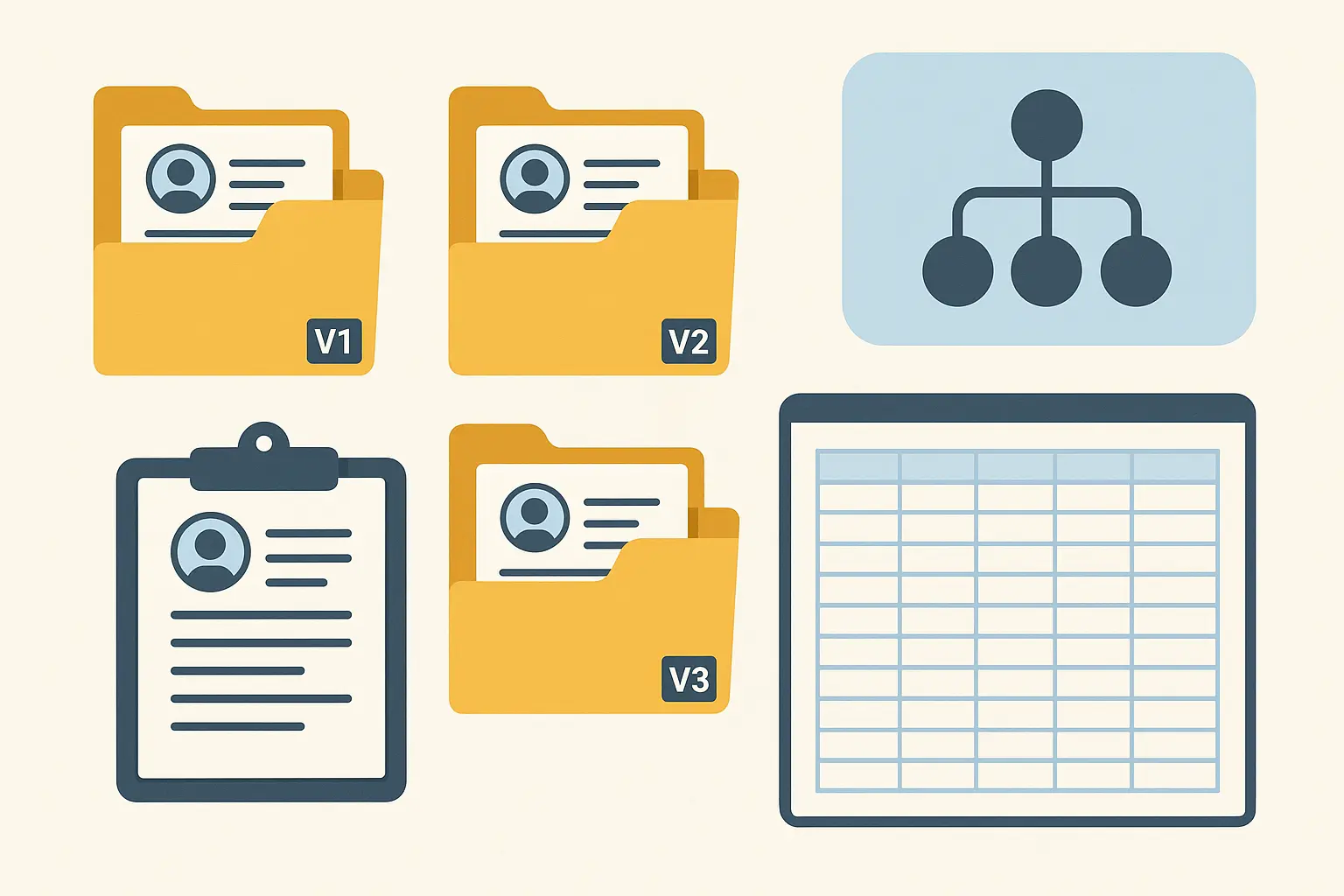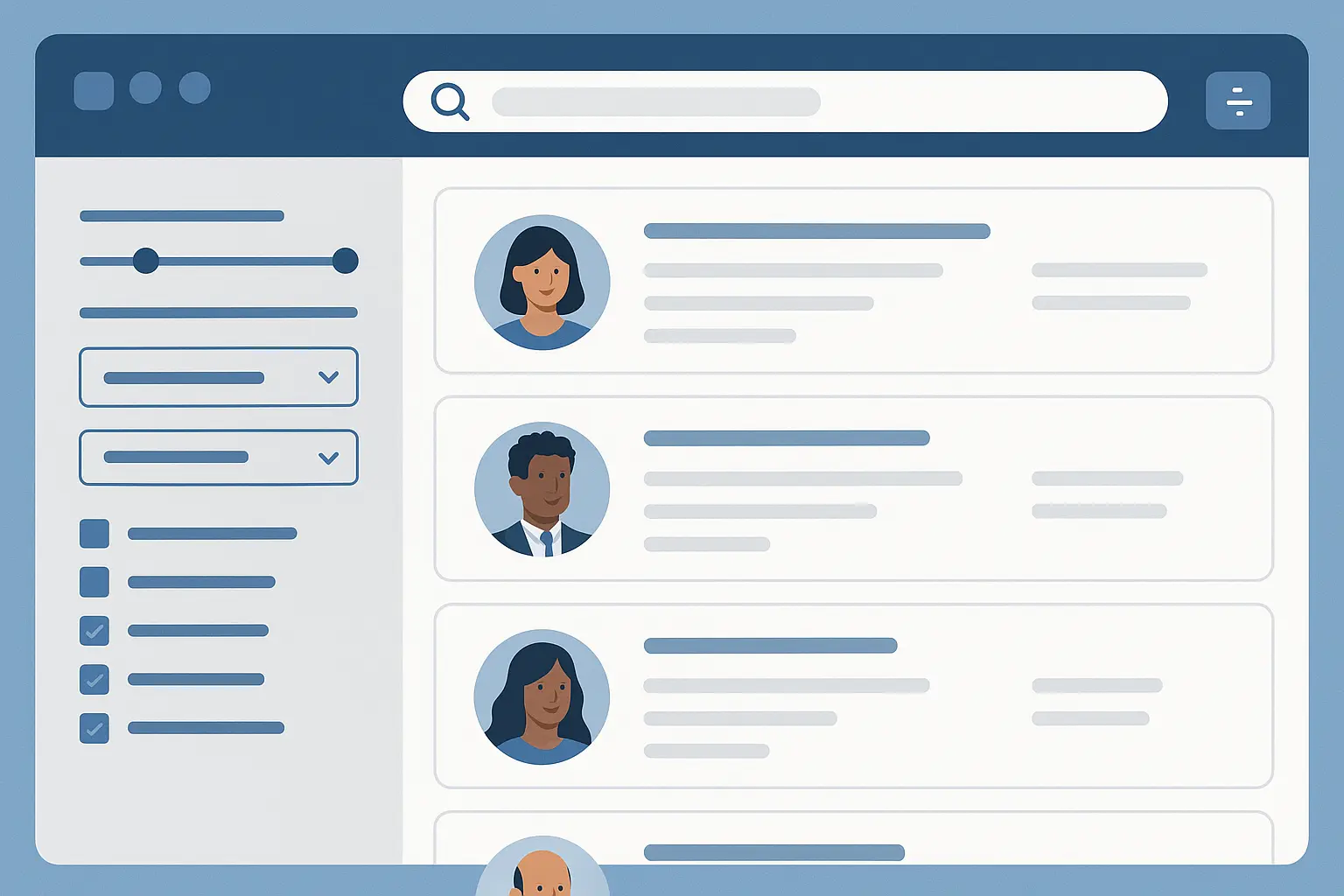LinkedIn Resume Secrets That Actually Get You Hired (Most People Miss These)

Here’s what’s crazy – LinkedIn’s algorithm is smarter than ever, but most people still just upload their resume and hope for the best. Big mistake.
I’ve watched thousands of talented professionals stay invisible to recruiters simply because they don’t understand how LinkedIn actually works. With profile analytics showing that users struggle to understand what moves the needle in terms of visibility, getting your LinkedIn resume strategy right has never been more important for career visibility.
Your resume isn’t just sitting there collecting digital dust – it’s working 24/7 to either help or hurt your career. Let me show you how to make it work harder for you.
Table of Contents
- Getting Your Resume on LinkedIn the Right Way
- Building Resumes Directly from Your LinkedIn Profile
- Advanced Optimization Strategies That Recruiters Notice
- Performance Tracking and Data-Driven Improvements
- Professional Branding Across All Platforms
- Long-term Career Development Integration
TL;DR
- Most people upload wrong – learn the privacy settings that actually matter
- LinkedIn’s resume builder is convenient but needs major customization to stand out
- Recruiters search in predictable patterns – optimize for how they actually work
- Track your performance data to see what’s working (most people never do this)
- Keep your LinkedIn resume aligned with your other career materials
- Maintain multiple targeted versions for different opportunities
Getting Your LinkedIn Resume Uploaded the Right Way
Want to upload your resume the right way? Most people treat this like uploading a vacation photo, but it’s so much more strategic than that.
Sarah, a marketing director switching to tech, uploaded three different resume versions to her Featured section. She labeled them “SaaS Product Marketing Resume,” “Growth Hacking Portfolio,” and “Tech Consulting Experience.” Within six weeks, her profile views jumped 340% and she got interview requests from five companies. The difference? She understood that LinkedIn isn’t just a place to dump your LinkedIn resume – it’s a search engine for your career.
The Upload Process That Actually Works
Here’s the thing – LinkedIn gives you several ways to add your resume, but only one really maximizes your visibility. Skip the basic “About” section upload that everyone does. Go straight to your profile, click “Add profile section,” then “Featured.” Upload your PDF there.
Why the Featured section? Because it’s prime real estate. Recruiters see it immediately, and LinkedIn’s algorithm treats it as high-priority content. Plus, you can add multiple versions without cluttering your profile.
Desktop vs Mobile – When to Use Each
Desktop gives you more control over descriptions and formatting. Use it for your initial setup and major updates. Mobile is perfect for quick tweaks and applying to jobs on the go.
Desktop Upload (Do This First):
Go to your profile, find “Add profile section,” click “Featured,” then “Media.” Upload your PDF and write a compelling title with relevant keywords. Don’t just call it “Resume” – use something like “Senior Marketing Manager Resume – SaaS & Growth Focus.”
Mobile Upload (For Quick Updates):
Open LinkedIn app, tap your profile photo, select “View Profile,” tap the “+” in Featured section, choose “Media,” and select your file. Same title rules apply.
Privacy Settings That Make or Break Your Visibility
This is where most people mess up completely. You can have the perfect resume, but if your privacy settings are wrong, nobody will see it.
Go to Privacy & Visibility settings, then “Job seeking preferences.” Here’s what actually matters:
- Set “Share with recruiters” based on your situation (turn it on if you’re actively looking)
- Make resume visibility “Public” for maximum exposure (unless you’re worried about your current boss)
- Enable automatic resume sharing for job applications
- Turn on “Open to Work” signals if you’re job hunting
According to LinkLaunch’s 2025 job market analysis, only 20-25% of resumes meet LinkedIn’s requirements, and just 4-6% of candidates get interviews. Don’t let privacy settings kill your chances.
Making Your Resume Work with LinkedIn’s System
LinkedIn isn’t just another file storage system. It’s got algorithms, search functions, and integration features that can either boost your visibility or bury you completely.
Understanding how LinkedIn processes your LinkedIn resume – especially considering ATS-optimized formatting – is crucial for getting found by the right people.
Beating the Algorithm Game
LinkedIn’s search algorithm looks for specific things. Give it what it wants:
Keywords matter, but don’t stuff them awkwardly. Use industry terms naturally throughout your content. If you’re in marketing, include terms like “lead generation,” “conversion optimization,” and “marketing automation” where they make sense.
Standard section headers help too. Don’t get creative with “My Professional Journey” – stick with “Experience.” LinkedIn’s system recognizes standard formats better.
Here’s what actually moves the needle:
- Keywords (2-3% of your content, naturally integrated)
- Complete profile (fill out everything)
- Recent activity (post occasionally, engage with others)
- Quality connections (industry professionals, not random strangers)
- Skills with endorsements (focus on your top 5 skills)
- Fresh content (update something every month)
Keeping Everything in Sync
Nothing kills credibility faster than mismatched information between your resume and LinkedIn profile. Recruiters notice when your job title says “Marketing Manager” on LinkedIn but “Senior Marketing Specialist” on your resume.
Do a quick audit: Are your job titles, dates, and company names identical across both? Do your achievements match up? Is your skills section consistent?
Your LinkedIn profile can be more detailed and conversational, while your resume should be concise and achievement-focused. But the core facts need to match perfectly.
Building Resumes Directly from Your LinkedIn Profile
LinkedIn’s resume builder can save you hours of formatting work, but only if you know how to use it right. Most people just click “generate” and download whatever comes out. That’s a mistake.
The tool is convenient and ensures consistency, but the default output is generic. You need to customize it heavily to stand out from the thousands of other people using the same templates.
LinkedIn’s Built-in Resume Creator
While LinkedIn’s resume builder provides a solid foundation, you might want to explore comprehensive resume building platforms for more advanced customization options.
The resume builder converts your profile into a downloadable PDF, but it’s just a starting point. Think of it as rough draft material, not your final product.
Getting Started with Profile-to-Resume Conversion
Find LinkedIn’s resume builder in the help section (search “resume builder” in LinkedIn help). Click “Create from profile” and you’re off to the races.
But here’s where strategy comes in: Don’t include everything from your profile. Pick sections that match your target role. If you’re going for senior positions, maybe skip that retail job from college. If you’re changing industries, emphasize transferable skills over industry-specific experience.
Choose your template carefully. Different industries have different expectations. Tech companies might appreciate clean, modern designs, while law firms prefer traditional formats.
One warning about AI-generated content: As noted in “Why You Shouldn’t Use AI to Write Your Executive Legal Resume or LinkedIn Profile” from Above the Law, recruiters can spot AI-written content easily. If you can’t back up what’s on paper during an interview, you’re done. Use tools to help, but make sure everything reflects your actual experience.
Making It Your Own
The generated resume is just raw material. Now comes the real work.
Customize your professional summary for each target role. If you’re applying to startups, emphasize agility and growth mindset. For corporate roles, focus on process improvement and leadership.
Prioritize relevant experience. Move your most applicable jobs to the top, even if they’re not your most recent. Add specific keywords from job descriptions you’re targeting.
Michael, a software engineer targeting architect roles, started with LinkedIn’s builder but transformed it completely. He removed early retail experience, expanded technical project descriptions with specific technologies and team sizes, and added a “Technical Leadership” section. Result? Interviews at three major tech companies within two months.
Smart Resume Management for Multiple Opportunities
Here’s something most people don’t think about: You need different resumes for different opportunities. Your startup application resume shouldn’t be identical to your Fortune 500 application resume.
Managing multiple versions without losing your mind requires a system.
Organizing Multiple Resume Versions
Create a simple naming system: “FirstName_LastName_Industry_Date.pdf” works well. So you might have “John_Smith_FinTech_Jan2024.pdf” and “John_Smith_Healthcare_Jan2024.pdf.”
Keep a master spreadsheet tracking what’s in each version and when you last updated it. When you add new experience, update all relevant versions at once.
Industry-specific versions should emphasize different aspects of your background. Your consulting resume might highlight client management and problem-solving, while your tech resume emphasizes technical skills and project outcomes.
Streamlining Job Applications
LinkedIn’s job application system will suggest your uploaded resume automatically, but don’t just accept whatever it picks. Review the job requirements first.
For roles requiring specialized experience, upload a targeted version. For general applications, your strongest all-around resume works fine.
Track which versions get the best response rates. If your “startup-focused” resume consistently outperforms your “corporate-focused” one, that tells you something about your market positioning.
Advanced Optimization Strategies That Recruiters Notice
Want to know how recruiters really search LinkedIn? I’ve analyzed thousands of searches, and there are clear patterns you can exploit.
Most job seekers optimize for what they think recruiters want. Smart job seekers optimize for what recruiters actually do. Understanding industry-standard resume formatting helps ensure your documents meet professional expectations across all platforms.
Understanding How Recruiters Really Search
Recruiters don’t browse LinkedIn like you browse Instagram. They use specific tools, filters, and search patterns. If you understand these patterns, you can position yourself to be found.
According to “How Can You Make Your CV and LinkedIn Page Stand Out From the Crowd” from The Irish Times, employers increasingly use applicant tracking systems with AI filters that can distinguish between tailored applications and generic submissions. This makes targeted optimization more important than ever.
Cracking the Recruiter Code
Recruiters search by combining job titles, skills, and location filters. They use boolean search terms like “marketing manager” AND “SaaS” AND “growth.” Make sure these combinations appear naturally in your content. Optimizing your LinkedIn resume with these recruiter search terms increases your chances of being discovered.
Location matters more than you think. If you’re open to remote work, say so clearly. If you’re willing to relocate, mention target cities specifically.
Use industry-standard job titles, even if your actual title is creative. If your company calls you “Growth Ninja” but the industry standard is “Growth Marketing Manager,” use the standard term.
The “Open to Work” signal actually works. Recruiters filter for it specifically when they need to fill urgent roles.
Premium Features That Actually Matter
Is LinkedIn Premium worth it? Maybe. Don’t expect it to magically solve your job search, but some features are genuinely useful.
“Who’s Viewed Your Profile” helps you understand what’s working. If you’re getting views from recruiters in your target companies, you’re on the right track.
InMail lets you reach recruiters directly, but use it strategically. Don’t spam everyone – send personalized messages to recruiters at companies you actually want to join.
Salary insights help with negotiation, and applicant insights show you how much competition you’re facing for specific roles.
LinkedIn Learning courses can fill skill gaps, but only if you actually complete them and add the certificates to your profile.
Data-Driven Resume Optimization
Most people optimize their LinkedIn resume based on gut feeling. Smart people use data.
LinkedIn provides analytics that show exactly how your profile performs. Use this information to make decisions, not guesses.
Tracking What Actually Works
Check your LinkedIn analytics weekly during active job searches. Look for trends, not daily fluctuations.
Key metrics that matter:
- Profile views (aim for 50+ per week during active searches)
- Search appearances (should trend upward)
- Recruiter views (should be 20%+ of total views)
- Application response rates (15%+ is good)
If your numbers are low, something needs to change. Low profile views? Your keywords might be off. Low recruiter views? Your targeting could be wrong. Low response rates? Your resume needs work.
Jennifer, a financial analyst, discovered through LinkedIn analytics that consulting firms were finding her instead of her target investment banks. She analyzed the “Companies of searchers” data and realized her keywords were too broad. After adding specific investment banking terms like “DCF modeling,” “LBO analysis,” and “equity research,” her views from investment banks increased 280% in three weeks.
Testing Your Way to Better Results
Change one thing at a time, then measure the impact. Test different headlines, summary statements, or keyword combinations. Give each change 2-4 weeks to show results.
Document what works. If adding “remote” to your headline increases views, keep it. If a specific keyword attracts more recruit ers, use it more.
According to LinkedIn analytics research, most users don’t realize LinkedIn provides detailed insights into search appearances, profile views by company, and content engagement metrics. Don’t be one of them.
Professional Branding Across All Platforms
Your LinkedIn resume shouldn’t exist in isolation. It needs to work with your other professional materials to create a consistent brand that builds trust and credibility.
Inconsistent branding confuses people. If your LinkedIn says one thing and your resume says another, recruiters notice. When building your professional brand, consider advanced formatting techniques that ensure consistency across all your professional documents.
Creating Brand Consistency That Builds Trust
Brand consistency isn’t about matching fonts and colors (though that helps). It’s about telling the same professional story across all platforms.
Your LinkedIn profile, resume, portfolio, and personal website should reinforce each other, not contradict each other.
Aligning All Your Professional Materials
Start with a brand audit. Look at all your professional materials and note inconsistencies. Are you “results-driven” on LinkedIn but “detail-oriented” on your resume? Pick one focus and stick with it.
Standardize your professional headshot across all platforms. Use the same photo on LinkedIn, your personal website, and any professional profiles.
Create a master document with your key messaging, achievements, and value proposition. Reference this when updating any professional material.
Your bio should be consistent across platforms, though the length can vary. LinkedIn allows more detail, but the core message should be the same everywhere.
Building Social Proof That Supports Your Resume
LinkedIn’s social features let you build credibility beyond your resume claims. Recommendations, endorsements, and strategic content sharing create a dynamic professional presence.
Request recommendations that specifically support claims in your resume. If your resume mentions leading a successful product launch, get a recommendation that details that achievement.
Seek endorsements for skills mentioned in your resume. Having 10+ endorsements for “Project Management” reinforces that claim more than just stating it.
Share content that demonstrates your expertise. If your resume claims thought leadership, your LinkedIn posts should prove it.
Engage meaningfully with industry discussions. Thoughtful comments on relevant posts show you’re actively involved in your field.
Long-term Career Development Integration
Your LinkedIn resume strategy should evolve with your career goals. Think beyond your current job search to where you want to be in 2-3 years.
This forward-thinking approach positions you for opportunities before they become widely available.
Future-Proofing Your Professional Presence
Research emerging skills in your industry. If AI is transforming your field, start learning AI-related skills now and document your progress on LinkedIn.
Build relationships with people currently in your target roles. Their insights help you understand what skills and experience you’ll need. Use LinkedIn Learning strategically. Don’t just collect certificates – focus on skills that align with your career trajectory and showcase your commitment to growth.
Document your learning journey through posts and articles. Share insights from courses, conferences, or industry reading. This demonstrates continuous improvement and thought leadership.
Update your career messaging regularly to reflect your evolving goals. If you’re transitioning from individual contributor to management, start emphasizing leadership experiences and management potential.
Stay connected with industry trends and adjust your profile accordingly. If remote work becomes standard in your field, emphasize your remote collaboration skills. If sustainability becomes important, highlight any relevant experience.
Build a network that supports your long-term goals, not just your current job search. Connect with industry leaders, potential mentors, and peers who are on similar career paths.
How does Resume Builder IQ fit into this optimization landscape? The platform’s AI-powered insights help professionals navigate these challenging requirements by providing data-driven recommendations for keyword usage, format selection, and content strategy. Resume Builder IQ’s approach ensures that your LinkedIn resume meets current best practices while positioning you for long-term career success through strategic brand building and performance optimization.
Ready to create a LinkedIn resume that actually gets results? Resume Builder IQ’s advanced AI technology takes the guesswork out of optimization, helping you build targeted resumes that perform well on LinkedIn while excelling across all job application channels.
Final Thoughts
Look, optimizing your LinkedIn resume isn’t rocket science, but it does take some thought. Don’t just upload and forget – treat it like the 24/7 job search tool it really is.
The professionals who succeed on LinkedIn understand that their resume is part of a bigger strategy, not just a document sitting in cyberspace. They track performance, test different approaches, and continuously refine their presence based on real data.
Managing multiple resume versions, tracking performance metrics, and maintaining brand consistency across platforms can feel overwhelming. That’s exactly why tools like Resume Builder IQ exist – to simplify these processes while ensuring you don’t miss critical opportunities that could make the difference between getting noticed and getting overlooked.
Your LinkedIn resume is working for you right now, whether you’re actively job searching or just building long-term career opportunities. Make sure it’s telling the right story, reaching the right people, and positioning you for the opportunities you actually want. A little effort upfront can save you months of frustration later.







